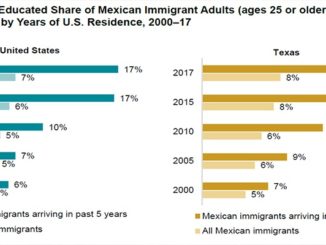
by Bill Hammond
Fourteen years ago, Texas enacted the DREAM Act (HB 1403), recognizing that the chance to succeed applies to all who live within this great state. Now there is a movement to modify or do away with it altogether. The simple fact is, without the Texas DREAM Act, the dream of a college education would be destroyed for the children of undocumented workers in the state of Texas.
Passed with bipartisan support and signed by Gov. Rick Perry in 2001, Texas’ DREAM Act allows all graduating Texas high school students — regardless of immigration status — to be eligible for in-state resident tuition. But it now faces threats of repeal, with critics claiming that it provides an “unfair advantage” to immigrant students and “lures immigrants to the border.”
That’s simply not the case, and a repeal of Texas’ DREAM Act would be tremendously shortsighted for the following reasons.
First, we would be severely limiting these students’ future as members of the Texas workforce. Since 2001, more than 24,000 students have benefitted from in-state tuition rates, thanks to HB 1403. These students simply want to give back to this state and the country they call home by working hard, getting a college education and becoming productive members of our society. If they are going to be a part of our communities one way or the other, what good does it do to limit their educational opportunities and ensure that they will not live up to their potential?
Second, by repealing the act, we would be punishing children for something they have no control over. These are students whose families came here because of Texas’ strong economy; the children made no illegal choice of their own. Under strict requirements, HB 1403 lets them pursue an in-state college education and join our workforce as well-educated contributors.
The Texas DREAM Act has strict rules for students to qualify for in-state tuition. First, they must have attended a Texas high school for a minimum of three years and graduated. Second, they must have applied for legal residency status. If those conditions aren’t met, they don’t qualify. This is not an unfair advantage; outside of pursuing legal residency, these are the exact same requirements for any Texas student to be eligible for in-state tuition.
College is expensive. Texas State University, for instance, charges $9,500 for in-state student tuition and fees for a nine-month period, which is about two semesters. The university’s out-of-state tuition rate is more than double at $20,360 for that same period.
For an immigrant family the choice is very simple. While there might be a chance at in-state rates, there is no chance at the out-of-state rate.
It is not the spirit of Texas to punish hardworking students or their parents. We must embrace our reality and take every step to ensure that our economy thrives and our workforce remains strong.
When Texas approved the DREAM Act, we all recognized that these students represent a part of our future workforce. While many things have changed between 2001 and 2015, that fact has not and will not change. The Texas DREAM Act helps our economy grow, makes our workforce competitive and gives us safer communities. Keeping the Texas DREAM Act is the right thing to do for these children and for Texas. Repealing it would be a true tragedy for our state, our nation, and for the American Dream.
Bill Hammond is CEO of the Texas Association of Business and lives in Austin.



